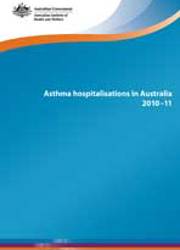Summary
Asthma is a common chronic condition of the airways, associated with episodes of wheezing, breathlessness, chest tightness and cough. Hospitalisation for asthma is rarely required as most symptoms are managed in the community through medication use and primary health care interventions. However, in cases where asthma exacerbations cannot be managed at home, hospitalisation may be required. This report provides an overview of these asthma hospitalisation patterns over time and across population groups.
In 2010-11 there were 37,830 hospitalisations where asthma was the principal diagnosis. The asthma hospitalisation rate (175 per 100,000 population) is low compared with other countries.
Hospitalisation for asthma decreased between 1998-99 and 2010-11. There was an overall reduction in the rate of hospitalisation for asthma among both children (33%) and adults (45%).
Asthma hospitalisation rates varied across population groups in 2010-11:
- The rate for Indigenous Australians was 2.1 times the rate for Other Australians.
- Among adults, rates were higher in areas that were more remote (83 per 100,000 population in Major cities and 214 per 100,000 in Very remote regions). This pattern was reversed among children, where rates were lower in areas that were more remote (511 per 100,000 in Major cities and 404 per 100,000 in Very remote regions).
- Rates were higher among people living in areas with the lowest socioeconomic status (209 per 100,000 population) than for those living in areas with the highest socioeconomic status (134 per 100,000 population).
- Rates for people born in a non-English-speaking country were lower than for those born in an English-speaking country, with the exception of those aged over 65, where the rates were higher.
Children had higher rates of hospitalisation for asthma than adults (495 compared with 92 per 100,000 population) although adults tended to stay in hospital for asthma longer than children: on average, 2.9 days compared with 1.5 days.
One in four people hospitalised with a principal diagnosis of asthma in 2010-11 had an acute respiratory infection recorded as an additional diagnosis.
Direct health expenditure for asthma was $655 million in 2008-09. The pattern of expenditure on asthma differs somewhat from the pattern for diseases overall. Half (50%) of all asthma expenditure in 2008-09 was attributed to prescription pharmaceuticals, (compared to 14% across all diseases) and a substantially lower proportion of asthma expenditure was attributed to admitted patient hospital care (20%), compared with total recurrent health expenditure across all diseases (52%).



